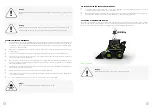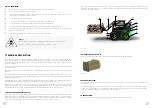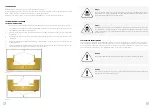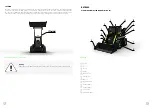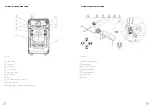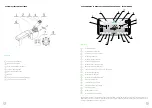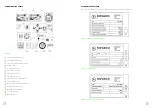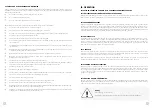
21
20
!
4.3 INAPPROPRIATE USE
The operator or the driver/vehicle operator, as opposed to the manufacturer, is liable for risks arising out of incorrect use
of the device.
Use of the machine for purposes other than specified in these operating instructions is prohibited.
4.4 PLACE OF USE
The loader can be used both outdoors and indoors. Use on public roads is permissible.
If you want to use the loader on public roads, it must meet the requirements of national standards of the country where it
is operated.
The road must have sufficient carrying capacity (tarmac, concrete).
Driving up or down a slope is permitted providing that the prescribed indications and specifications in these operating
instructions are observed.
The loader can be used indoors and outdoors, from northern regions to the tropical zones (temperature range -20 to
+40 °C).
4.5 PARKING AT TEMPERATURES BELOW -10 °C
4.6 USE OF WORK PLATFORMS
Danger
The loader must not be used in places where there is a risk of fire, explosion or corrosion.
Loading and stacking loads on inclined surfaces or ramps is prohibited.
Danger
The use of work platforms is prohibited!
Warning
Batteries may freeze!
If the loader is parked for a long time in an environment with temperatures below -10 °C, the bat-
teries will cool down. The electrolyte may freeze and damage the batteries. In such an event, the
loader will not be ready for operation.
If the ambient temperature drops below -10 °C, park the loader in such conditions only for a short
time, or only for as long as absolutely necessary, or ensure that the battery is connected to the
charger throughout the duration of parking.
4.7 RESIDUAL RISK
Even with careful operation and compliance with all standards and regulations, risks cannot be completely excluded when
using the loader.
The components of the loader and of the entire system meet current safety requirements. Even when the loader is used
exclusively for its intended purpose and all instructions are followed, certain residual risks cannot be ruled out.
Such residual risks cannot be completely excluded even outside the narrow risk zone around the loader. Persons in the
vicinity of the loader must be extremely vigilant so that they can react immediately in the event of a malfunction, crash,
accident etc.
The risks include:
Leakage of operating fluids due to cracks or ruptures of pipes and tanks;
Risk of accident when driving over difficult terrain or surfaces such as slopes, smooth or uneven surfaces,
or at poor visibility, etc.;
Falling, tripping, etc. when mounting the loader, especially in wet weather or with leaking working fluids,
or on icy surfaces;
Risk of fire and explosion caused by batteries and electric voltage;
Human error as a result of non-compliance with safety regulations;
Unattended damage or wrong and worn parts;
Insufficient maintenance and inspections;
Use of wrong consumables;
Not observing inspection intervals.
The manufacturer is not liable for accidents involving the loader which may occur as a result of the operator’s non-compli-
ance with these instructions - whether intentional or due to negligence.
Danger
All persons in the vicinity of the loader must be instructed on the risks arising from its use.
Danger
Danger of injury when the loader overturns!
Use the seat belt!
Even if using an approved restraint system, there is a residual risk of injury should the loader overturn. This risk of injury can
be reduced by the combined use of a restraint system and the seat belt. In addition, the seat belt protects against the conse-
quences of rear-end collisions and ramp fall accidents.


















